Ultraviolet – visible spectroscopy (λ 200 — 800

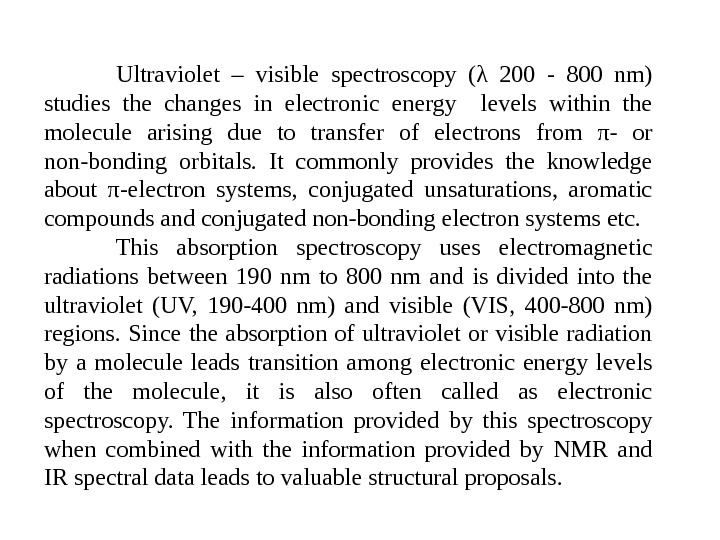
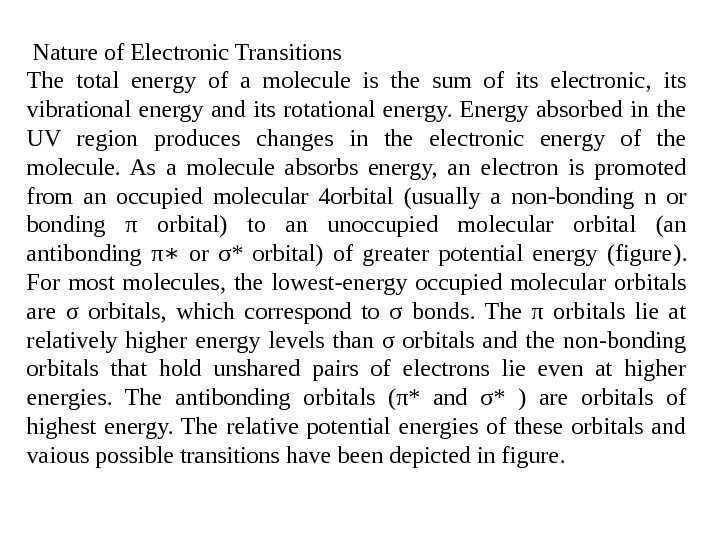
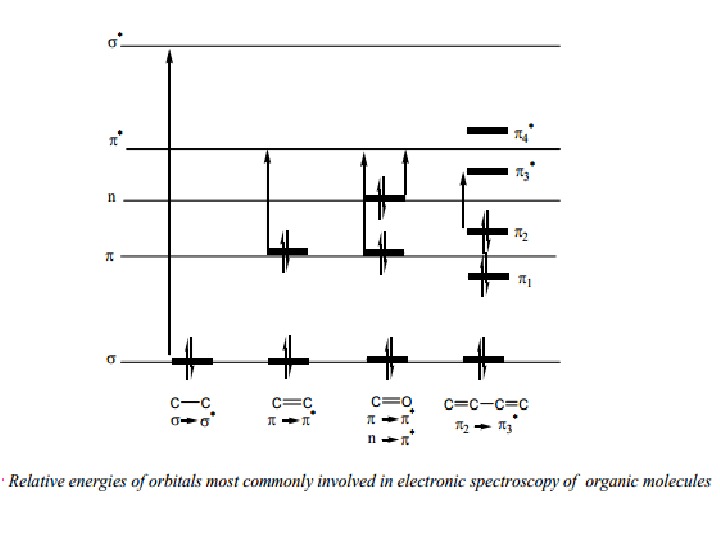




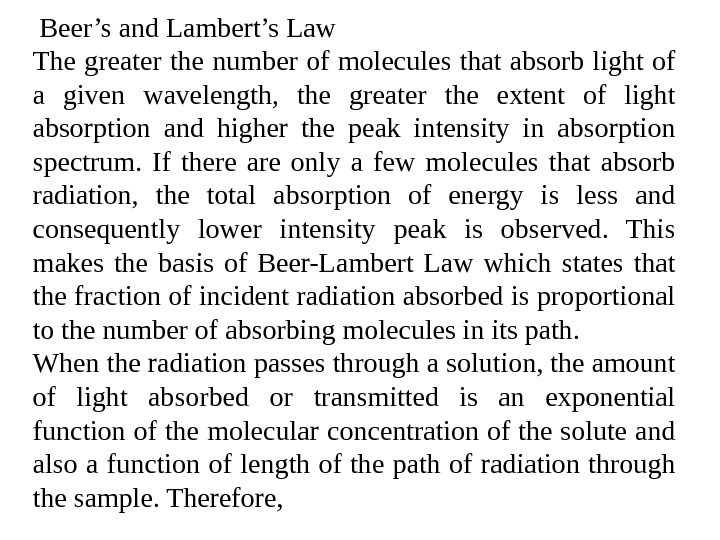



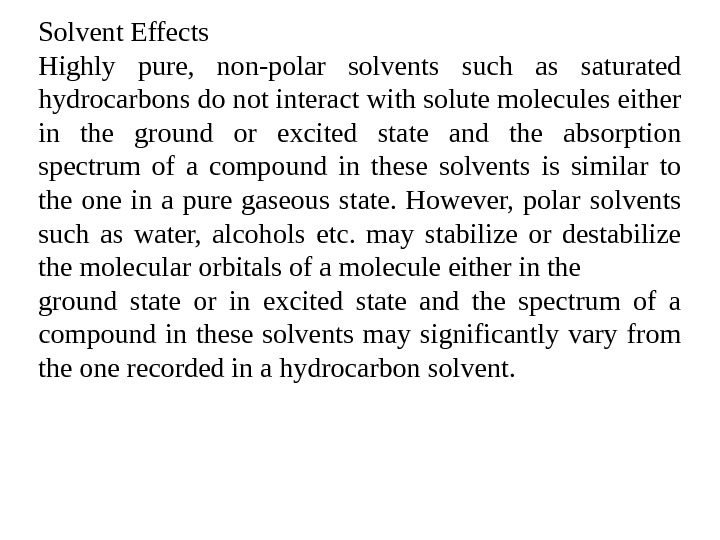

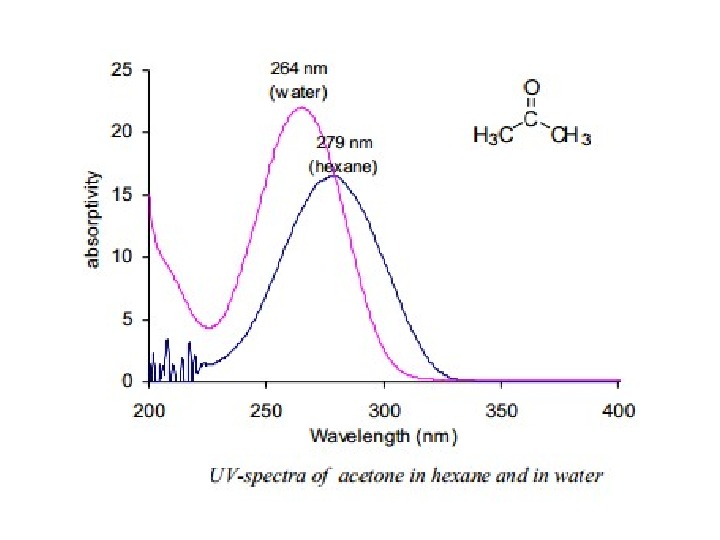
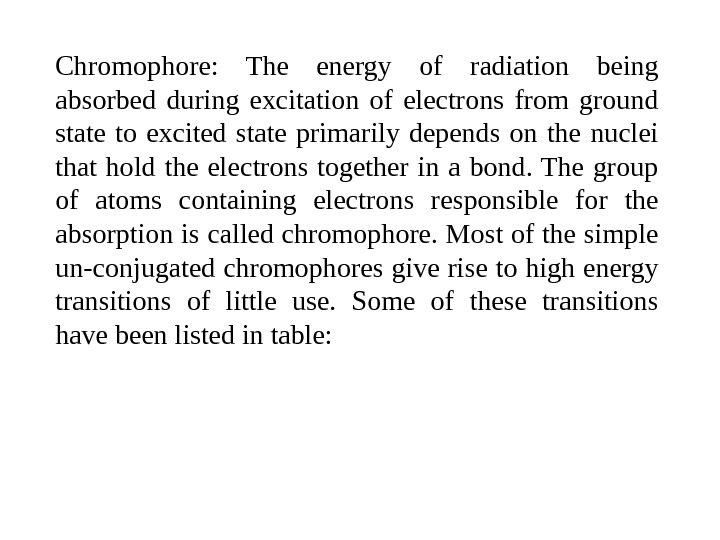
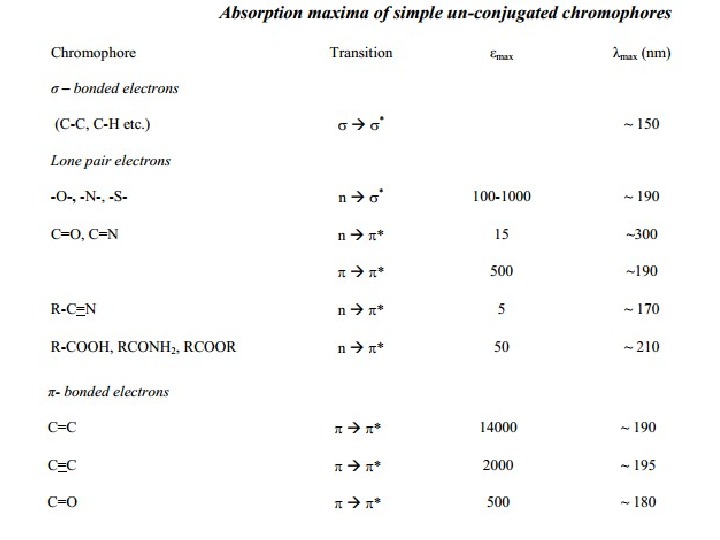
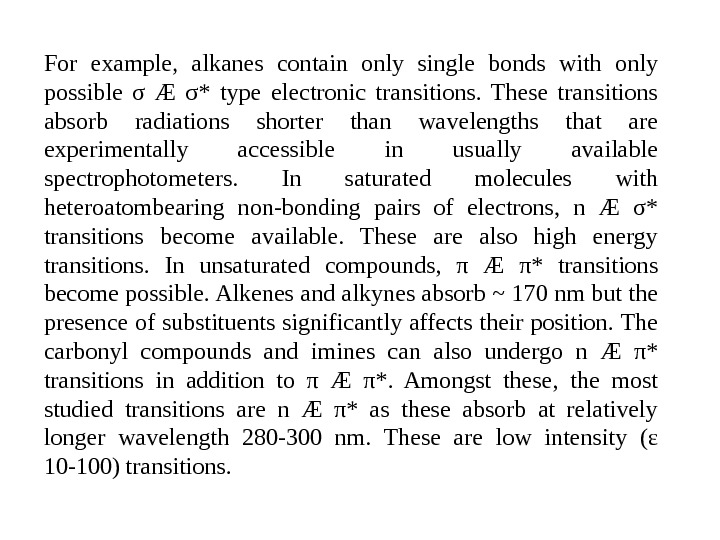

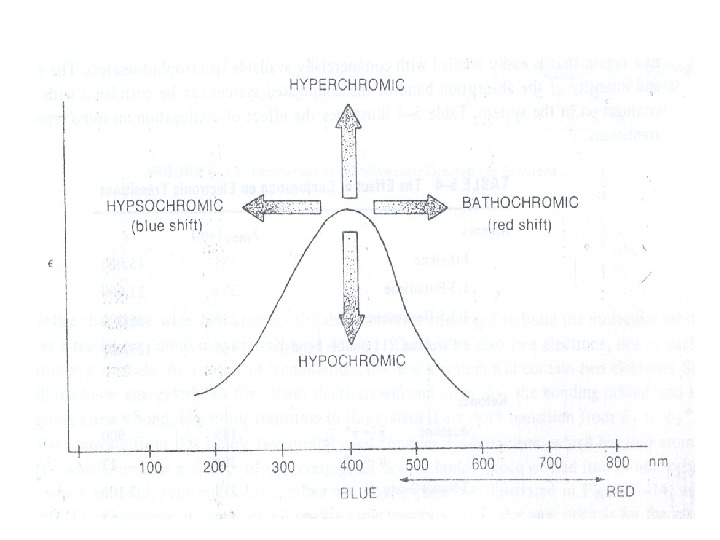



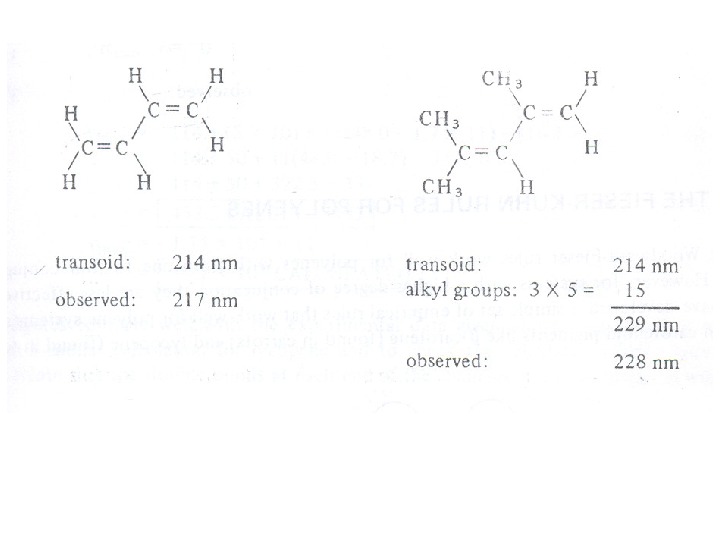


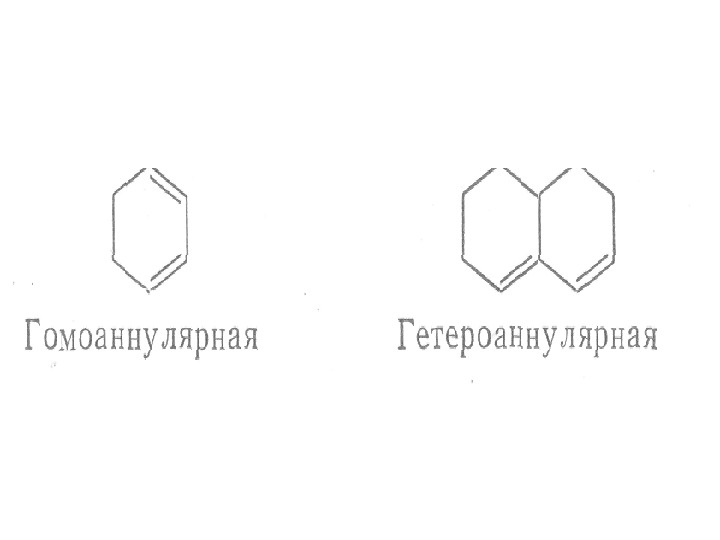
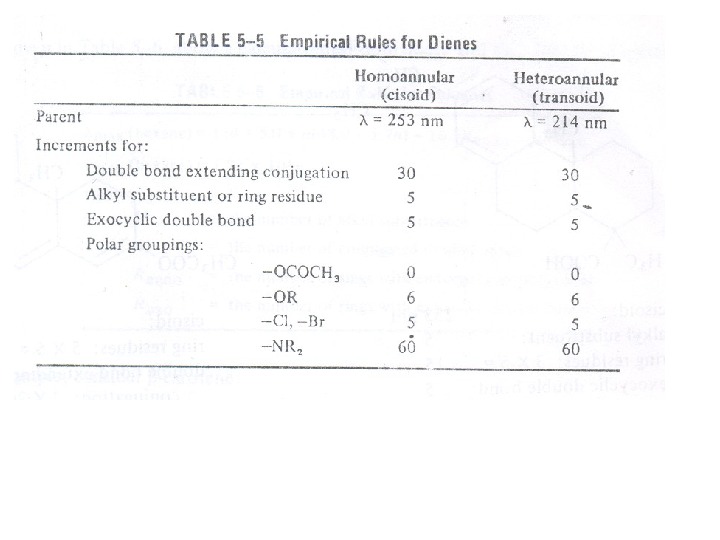

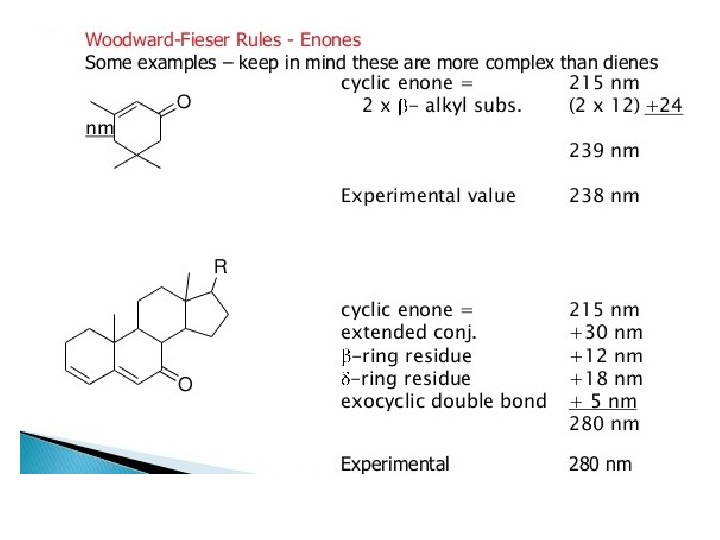
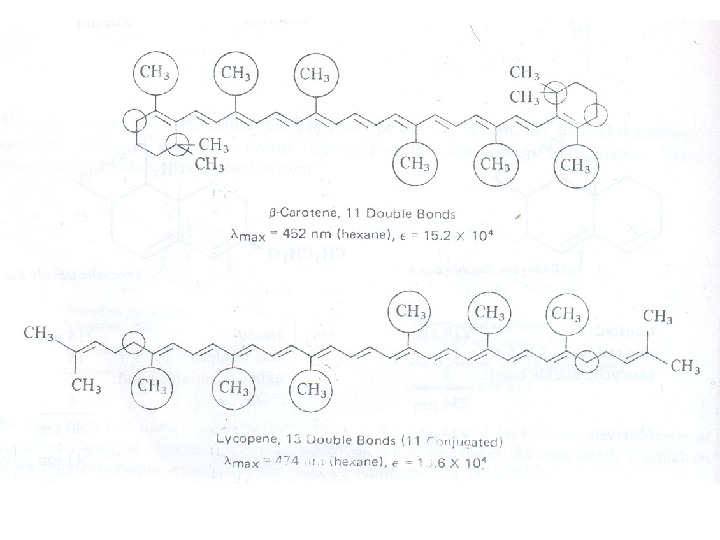
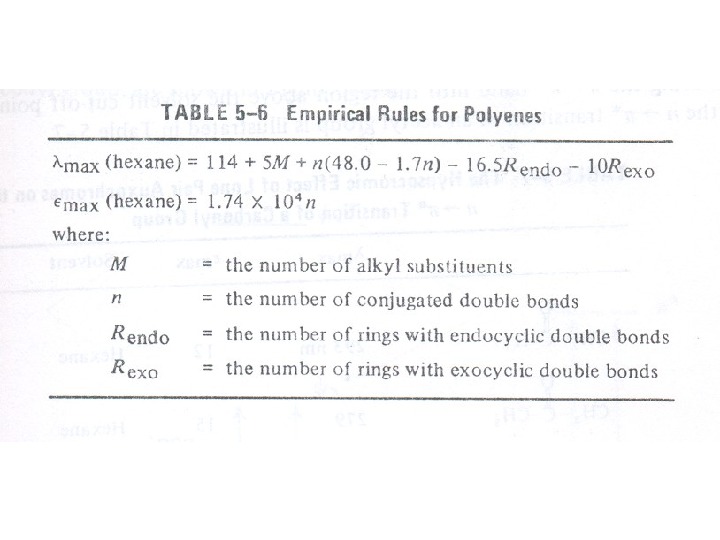

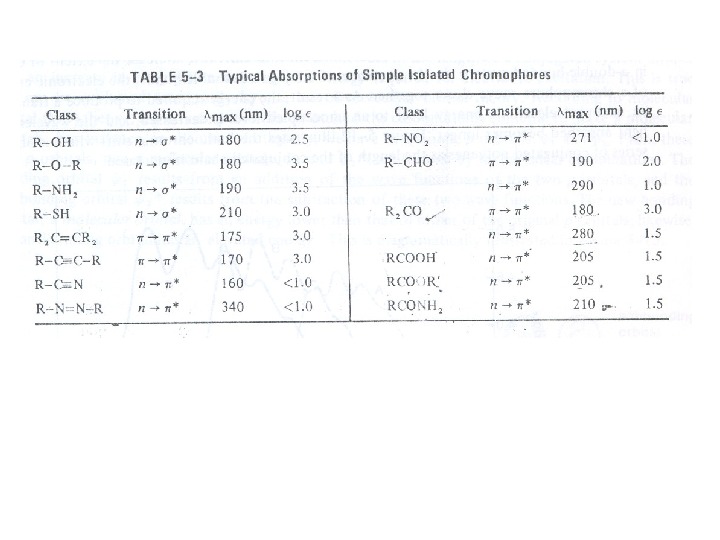
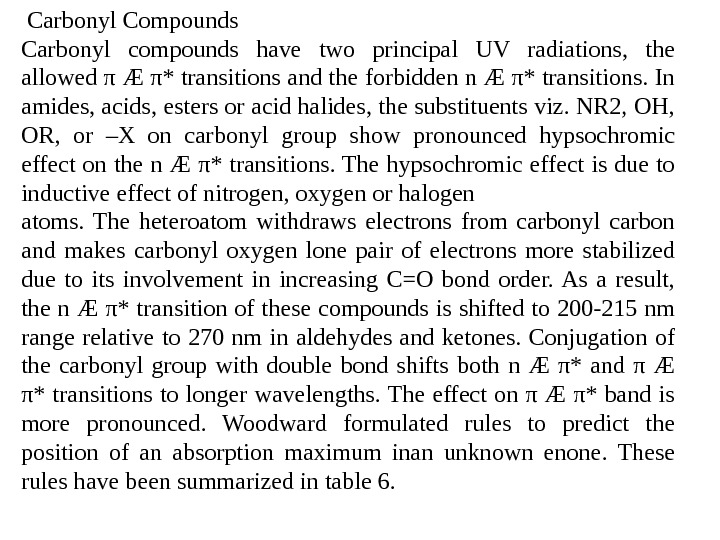
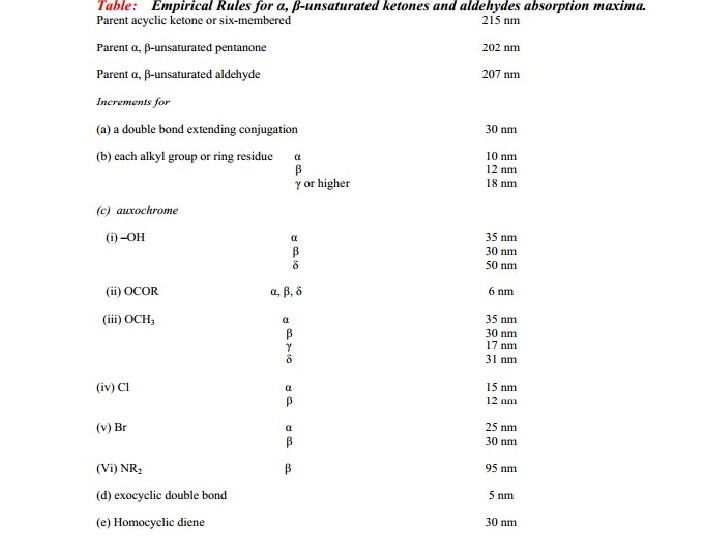
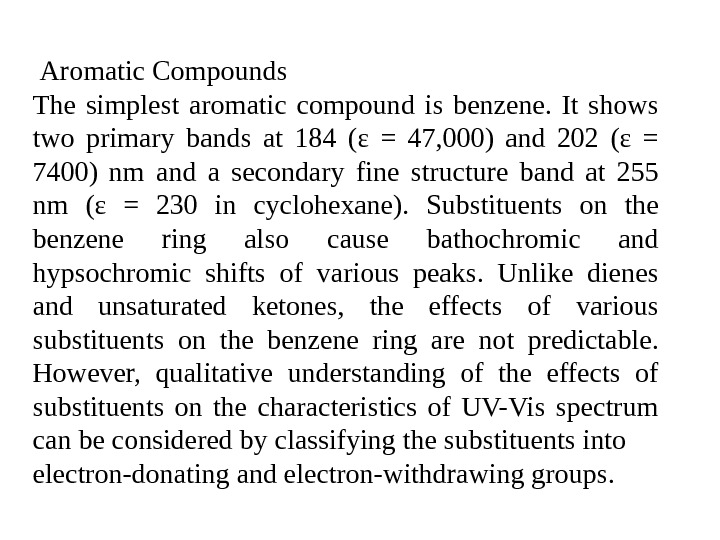
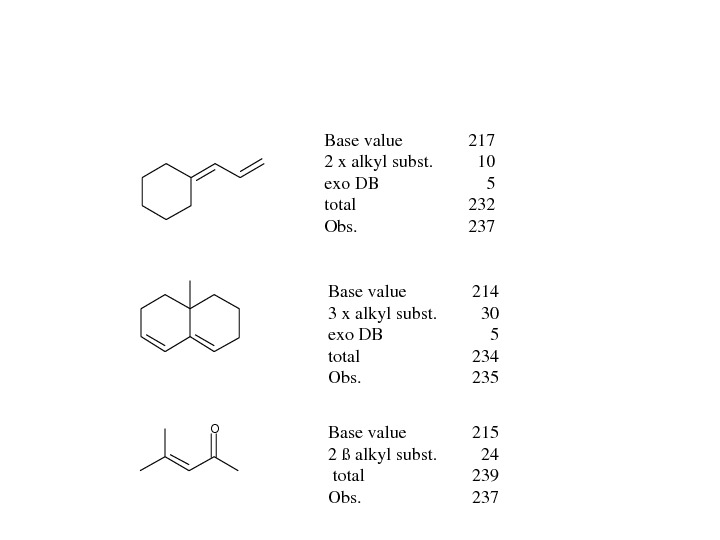
- Размер: 5.1 Mегабайта
- Количество слайдов: 37
Описание презентации Ultraviolet – visible spectroscopy (λ 200 — 800 по слайдам
 Ultraviolet – visible spectroscopy (λ 200 — 800 nm) studies the changes in electronic energy levels within the molecule arising due to transfer of electrons from π- or non-bonding orbitals. It commonly provides the knowledge about π-electron systems, conjugated unsaturations, aromatic compounds and conjugated non-bonding electron systems etc. This absorption spectroscopy uses electromagnetic radiations between 190 nm to 800 nm and is divided into the ultraviolet (UV, 190 -400 nm) and visible (VIS, 400 -800 nm) regions. Since the absorption of ultraviolet or visible radiation by a molecule leads transition among electronic energy levels of the molecule, it is also often called as electronic spectroscopy. The information provided by this spectroscopy when combined with the information provided by NMR and IR spectral data leads to valuable structural proposals.
Ultraviolet – visible spectroscopy (λ 200 — 800 nm) studies the changes in electronic energy levels within the molecule arising due to transfer of electrons from π- or non-bonding orbitals. It commonly provides the knowledge about π-electron systems, conjugated unsaturations, aromatic compounds and conjugated non-bonding electron systems etc. This absorption spectroscopy uses electromagnetic radiations between 190 nm to 800 nm and is divided into the ultraviolet (UV, 190 -400 nm) and visible (VIS, 400 -800 nm) regions. Since the absorption of ultraviolet or visible radiation by a molecule leads transition among electronic energy levels of the molecule, it is also often called as electronic spectroscopy. The information provided by this spectroscopy when combined with the information provided by NMR and IR spectral data leads to valuable structural proposals.
 Nature of Electronic Transitions The total energy of a molecule is the sum of its electronic, its vibrational energy and its rotational energy. Energy absorbed in the UV region produces changes in the electronic energy of the molecule. As a molecule absorbs energy, an electron is promoted from an occupied molecular 4 orbital (usually a non-bonding n or bonding π orbital) to an unoccupied molecular orbital (an antibonding π or σ* orbital) of greater potential energy (figure∗ ). For most molecules, the lowest-energy occupied molecular orbitals are σ orbitals, which correspond to σ bonds. The π orbitals lie at relatively higher energy levels than σ orbitals and the non-bonding orbitals that hold unshared pairs of electrons lie even at higher energies. The antibonding orbitals (π* and σ* ) are orbitals of highest energy. The relative potential energies of these orbitals and vaious possible transitions have been depicted in figure.
Nature of Electronic Transitions The total energy of a molecule is the sum of its electronic, its vibrational energy and its rotational energy. Energy absorbed in the UV region produces changes in the electronic energy of the molecule. As a molecule absorbs energy, an electron is promoted from an occupied molecular 4 orbital (usually a non-bonding n or bonding π orbital) to an unoccupied molecular orbital (an antibonding π or σ* orbital) of greater potential energy (figure∗ ). For most molecules, the lowest-energy occupied molecular orbitals are σ orbitals, which correspond to σ bonds. The π orbitals lie at relatively higher energy levels than σ orbitals and the non-bonding orbitals that hold unshared pairs of electrons lie even at higher energies. The antibonding orbitals (π* and σ* ) are orbitals of highest energy. The relative potential energies of these orbitals and vaious possible transitions have been depicted in figure.

 The saturated aliphatic hydrocarbons (alkanes) exhibit only σ σ* transitions but depending on the functional groups the organic molecules may undergo several possible transitions which can be placed in the increasing order of their energies viz. n π* < n σ* < π π* < σ σ*. Since all these transitions require fixed amount of energy (quantized), an ultraviolet or visible spectrum of a compound would consist of one or more well defined peaks, each corresponding to the transfer of an electron from one electronic level to another. If the differences between electronic energy levels of two electronic states are well defined i. e. if the nuclei of the two atoms of a diatomic molecule are held in fixed position, the peaks accordingly should be sharp. However, vibrations and rotations of nuclei occur constantly and as a result each electronic state in a molecule is associated with a large number of vibrational and rotational states.
The saturated aliphatic hydrocarbons (alkanes) exhibit only σ σ* transitions but depending on the functional groups the organic molecules may undergo several possible transitions which can be placed in the increasing order of their energies viz. n π* < n σ* < π π* < σ σ*. Since all these transitions require fixed amount of energy (quantized), an ultraviolet or visible spectrum of a compound would consist of one or more well defined peaks, each corresponding to the transfer of an electron from one electronic level to another. If the differences between electronic energy levels of two electronic states are well defined i. e. if the nuclei of the two atoms of a diatomic molecule are held in fixed position, the peaks accordingly should be sharp. However, vibrations and rotations of nuclei occur constantly and as a result each electronic state in a molecule is associated with a large number of vibrational and rotational states.
 Sigma and Pi orbitals
Sigma and Pi orbitals
 Electron transitions
Electron transitions

 Beer’s and Lambert’s Law The greater the number of molecules that absorb light of a given wavelength, the greater the extent of light absorption and higher the peak intensity in absorption spectrum. If there are only a few molecules that absorb radiation, the total absorption of energy is less and consequently lower intensity peak is observed. This makes the basis of Beer-Lambert Law which states that the fraction of incident radiation absorbed is proportional to the number of absorbing molecules in its path. When the radiation passes through a solution, the amount of light absorbed or transmitted is an exponential function of the molecular concentration of the solute and also a function of length of the path of radiation through the sample. Therefore,
Beer’s and Lambert’s Law The greater the number of molecules that absorb light of a given wavelength, the greater the extent of light absorption and higher the peak intensity in absorption spectrum. If there are only a few molecules that absorb radiation, the total absorption of energy is less and consequently lower intensity peak is observed. This makes the basis of Beer-Lambert Law which states that the fraction of incident radiation absorbed is proportional to the number of absorbing molecules in its path. When the radiation passes through a solution, the amount of light absorbed or transmitted is an exponential function of the molecular concentration of the solute and also a function of length of the path of radiation through the sample. Therefore,



 Solvent Effects Highly pure, non-polar solvents such as saturated hydrocarbons do not interact with solute molecules either in the ground or excited state and the absorption spectrum of a compound in these solvents is similar to the one in a pure gaseous state. However, polar solvents such as water, alcohols etc. may stabilize or destabilize the molecular orbitals of a molecule either in the ground state or in excited state and the spectrum of a compound in these solvents may significantly vary from the one recorded in a hydrocarbon solvent.
Solvent Effects Highly pure, non-polar solvents such as saturated hydrocarbons do not interact with solute molecules either in the ground or excited state and the absorption spectrum of a compound in these solvents is similar to the one in a pure gaseous state. However, polar solvents such as water, alcohols etc. may stabilize or destabilize the molecular orbitals of a molecule either in the ground state or in excited state and the spectrum of a compound in these solvents may significantly vary from the one recorded in a hydrocarbon solvent.
 π Æ π* Transitions In case of π Æ π* transitions, the excited states are more polar than the ground state and the dipole-dipole interactions with solvent molecules lower the energy of the excited state more than that of the ground state. Therefore a polar solvent decreases the energy of π Æ π* transition andabsorption maximum appears ~10 -20 nm red shifted in going from hexane to ethanol solvent. 8(ii) n Æ π* Transitions In case of n Æ π* transitions, the polar solvents form hydrogen bonds with the ground state of polar molecules more readily than with their excited states. Therefore, in polar solvents the energies of electronic transitions are increased. For example, the figure 5 shows that theabsorption maximum of acetone in hexane appears at 279 nm which in water is shifted to 264 nm, with a blue shift of 15 nm.
π Æ π* Transitions In case of π Æ π* transitions, the excited states are more polar than the ground state and the dipole-dipole interactions with solvent molecules lower the energy of the excited state more than that of the ground state. Therefore a polar solvent decreases the energy of π Æ π* transition andabsorption maximum appears ~10 -20 nm red shifted in going from hexane to ethanol solvent. 8(ii) n Æ π* Transitions In case of n Æ π* transitions, the polar solvents form hydrogen bonds with the ground state of polar molecules more readily than with their excited states. Therefore, in polar solvents the energies of electronic transitions are increased. For example, the figure 5 shows that theabsorption maximum of acetone in hexane appears at 279 nm which in water is shifted to 264 nm, with a blue shift of 15 nm.

 Chromophore: The energy of radiation being absorbed during excitation of electrons from ground state to excited state primarily depends on the nuclei that hold the electrons together in a bond. The group of atoms containing electrons responsible for the absorption is called chromophore. Most of the simple un-conjugated chromophores give rise to high energy transitions of little use. Some of these transitions have been listed in table:
Chromophore: The energy of radiation being absorbed during excitation of electrons from ground state to excited state primarily depends on the nuclei that hold the electrons together in a bond. The group of atoms containing electrons responsible for the absorption is called chromophore. Most of the simple un-conjugated chromophores give rise to high energy transitions of little use. Some of these transitions have been listed in table:

 For example, alkanes contain only single bonds with only possible σ Æ σ* type electronic transitions. These transitions absorb radiations shorter than wavelengths that are experimentally accessible in usually available spectrophotometers. In saturated molecules with heteroatombearing non-bonding pairs of electrons, n Æ σ* transitions become available. These are also high energy transitions. In unsaturated compounds, π Æ π* transitions become possible. Alkenes and alkynes absorb ~ 170 nm but the presence of substituents significantly affects their position. The carbonyl compounds and imines can also undergo n Æ π* transitions in addition to π Æ π*. Amongst these, the most studied transitions are n Æ π* as these absorb at relatively longer wavelength 280 -300 nm. These are low intensity (ε 10 -100) transitions.
For example, alkanes contain only single bonds with only possible σ Æ σ* type electronic transitions. These transitions absorb radiations shorter than wavelengths that are experimentally accessible in usually available spectrophotometers. In saturated molecules with heteroatombearing non-bonding pairs of electrons, n Æ σ* transitions become available. These are also high energy transitions. In unsaturated compounds, π Æ π* transitions become possible. Alkenes and alkynes absorb ~ 170 nm but the presence of substituents significantly affects their position. The carbonyl compounds and imines can also undergo n Æ π* transitions in addition to π Æ π*. Amongst these, the most studied transitions are n Æ π* as these absorb at relatively longer wavelength 280 -300 nm. These are low intensity (ε 10 -100) transitions.
 Auxochrome: The substituents that themselves do not absorb ultraviolet radiations but their presence shifts the absorption maximum to longer wavelength are called auxochromes. The substituents like methyl, hydroxyl, alkoxy, halogen, amino group etc. are some examples of auxochromes. (iii) Bathochromic Shift or Red shift: A shift of an absorption maximum towards longer wavelength or lower energy. (iv) Hypsochromic Shift or Blue Shift: A shift of an absorption maximum towards shorter wavelength or higher energy. (v) Hypochromic Effect: An effect that results in decreased absorption intensity. vi) Hyperchromic Effect: An effect that results in increased absorption intensity.
Auxochrome: The substituents that themselves do not absorb ultraviolet radiations but their presence shifts the absorption maximum to longer wavelength are called auxochromes. The substituents like methyl, hydroxyl, alkoxy, halogen, amino group etc. are some examples of auxochromes. (iii) Bathochromic Shift or Red shift: A shift of an absorption maximum towards longer wavelength or lower energy. (iv) Hypsochromic Shift or Blue Shift: A shift of an absorption maximum towards shorter wavelength or higher energy. (v) Hypochromic Effect: An effect that results in decreased absorption intensity. vi) Hyperchromic Effect: An effect that results in increased absorption intensity.

 Conjugated Dienes, Trienes and Polyenes The presence of conjugate double bond decreases the energy difference between HOMO and LUMO of resulting diene. The figure 6 shows the change in energy of MO on conjugation. As a result, the radiations of longer wavelength are absorbed. The conjugation not only results in bathochromic shift (longer wavelength) but also increases the intensity of absorption. As the number of conjugated double bonds is increased, the gap between highest occupied molecular orbital (HOMO) and lowest unoccupied molecular orbital (LUMO) is progressively lowered. Therefore, the increase in size of the conjugated system gradually shifts the absorption maximum (λmax) to longer wavelength and also increases the absorption. For example, ethylene absorbs at 10175 nm (ε = 1000) and the conjugation in butadiene gives a strong absorption at longer wavelength at 230 nm and with higher intensity (ε = >1000).
Conjugated Dienes, Trienes and Polyenes The presence of conjugate double bond decreases the energy difference between HOMO and LUMO of resulting diene. The figure 6 shows the change in energy of MO on conjugation. As a result, the radiations of longer wavelength are absorbed. The conjugation not only results in bathochromic shift (longer wavelength) but also increases the intensity of absorption. As the number of conjugated double bonds is increased, the gap between highest occupied molecular orbital (HOMO) and lowest unoccupied molecular orbital (LUMO) is progressively lowered. Therefore, the increase in size of the conjugated system gradually shifts the absorption maximum (λmax) to longer wavelength and also increases the absorption. For example, ethylene absorbs at 10175 nm (ε = 1000) and the conjugation in butadiene gives a strong absorption at longer wavelength at 230 nm and with higher intensity (ε = >1000).
 The presence of alkyl substituents on double bond also produces bathochromic shift and hyperchromic effect. These effects are additive in dienes and up to some extent in trienes. The open chain dienes can achieve s-cis or s-trans conformations and similarly diene system can behomoannular or heteroannular in cyclic systems. In 1941, Woodward suggested empirical rules for predicting the absorption of open chain and six-membered ring dienes which have been later on extended to large number of dienes and trienes (Table).
The presence of alkyl substituents on double bond also produces bathochromic shift and hyperchromic effect. These effects are additive in dienes and up to some extent in trienes. The open chain dienes can achieve s-cis or s-trans conformations and similarly diene system can behomoannular or heteroannular in cyclic systems. In 1941, Woodward suggested empirical rules for predicting the absorption of open chain and six-membered ring dienes which have been later on extended to large number of dienes and trienes (Table).












 Carbonyl Compounds Carbonyl compounds have two principal UV radiations, the allowed π Æ π* transitions and the forbidden n Æ π* transitions. In amides, acids, esters or acid halides, the substituents viz. NR 2, OH, OR, or –X on carbonyl group show pronounced hypsochromic effect on the n Æ π* transitions. The hypsochromic effect is due to inductive effect of nitrogen, oxygen or halogen atoms. The heteroatom withdraws electrons from carbonyl carbon and makes carbonyl oxygen lone pair of electrons more stabilized due to its involvement in increasing C=O bond order. As a result, the n Æ π* transition of these compounds is shifted to 200 -215 nm range relative to 270 nm in aldehydes and ketones. Conjugation of the carbonyl group with double bond shifts both n Æ π* and π Æ π* transitions to longer wavelengths. The effect on π Æ π* band is more pronounced. Woodward formulated rules to predict the position of an absorption maximum inan unknown enone. These rules have been summarized in table 6.
Carbonyl Compounds Carbonyl compounds have two principal UV radiations, the allowed π Æ π* transitions and the forbidden n Æ π* transitions. In amides, acids, esters or acid halides, the substituents viz. NR 2, OH, OR, or –X on carbonyl group show pronounced hypsochromic effect on the n Æ π* transitions. The hypsochromic effect is due to inductive effect of nitrogen, oxygen or halogen atoms. The heteroatom withdraws electrons from carbonyl carbon and makes carbonyl oxygen lone pair of electrons more stabilized due to its involvement in increasing C=O bond order. As a result, the n Æ π* transition of these compounds is shifted to 200 -215 nm range relative to 270 nm in aldehydes and ketones. Conjugation of the carbonyl group with double bond shifts both n Æ π* and π Æ π* transitions to longer wavelengths. The effect on π Æ π* band is more pronounced. Woodward formulated rules to predict the position of an absorption maximum inan unknown enone. These rules have been summarized in table 6.

 Aromatic Compounds The simplest aromatic compound is benzene. It shows two primary bands at 184 (ε = 47, 000) and 202 (ε = 7400) nm and a secondary fine structure band at 255 nm (ε = 230 in cyclohexane). Substituents on the benzene ring also cause bathochromic and hypsochromic shifts of various peaks. Unlike dienes and unsaturated ketones, the effects of various substituents on the benzene ring are not predictable. However, qualitative understanding of the effects of substituents on the characteristics of UV-Vis spectrum can be considered by classifying the substituents into electron-donating and electron-withdrawing groups.
Aromatic Compounds The simplest aromatic compound is benzene. It shows two primary bands at 184 (ε = 47, 000) and 202 (ε = 7400) nm and a secondary fine structure band at 255 nm (ε = 230 in cyclohexane). Substituents on the benzene ring also cause bathochromic and hypsochromic shifts of various peaks. Unlike dienes and unsaturated ketones, the effects of various substituents on the benzene ring are not predictable. However, qualitative understanding of the effects of substituents on the characteristics of UV-Vis spectrum can be considered by classifying the substituents into electron-donating and electron-withdrawing groups.
 OBasevalue 217 2 xalkylsubst. 10 exo. DB 5 total 232 Obs. 237 Basevalue 214 3 xalkylsubst. 30 exo. DB 5 total 234 Obs. 235 Basevalue 215 2ßalkylsubst. 24 total 239 Obs.
OBasevalue 217 2 xalkylsubst. 10 exo. DB 5 total 232 Obs. 237 Basevalue 214 3 xalkylsubst. 30 exo. DB 5 total 234 Obs. 235 Basevalue 215 2ßalkylsubst. 24 total 239 Obs.

